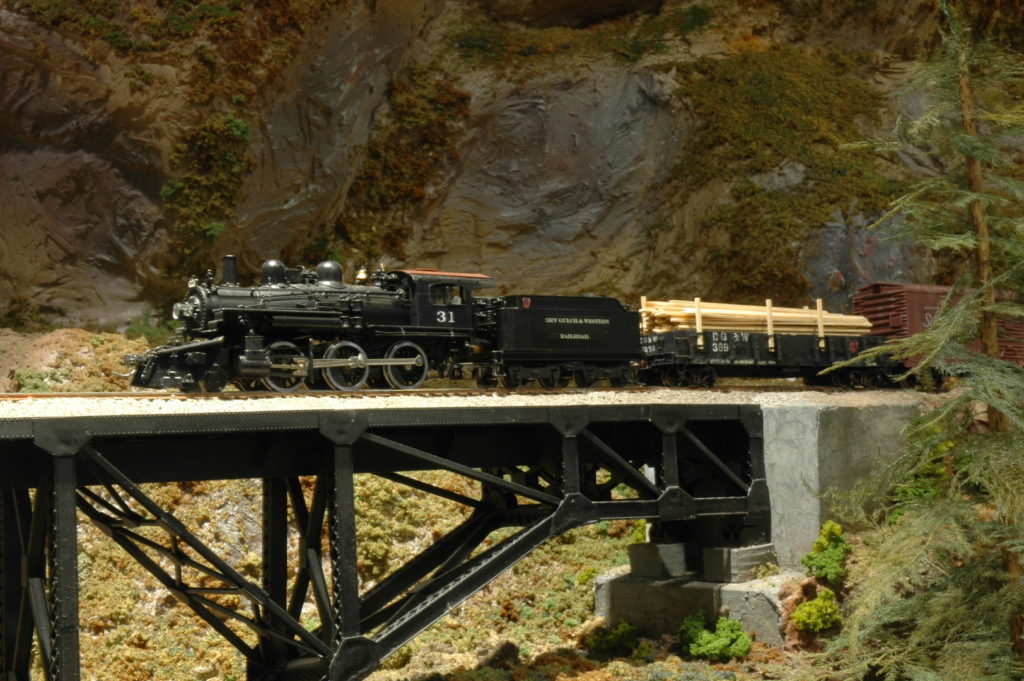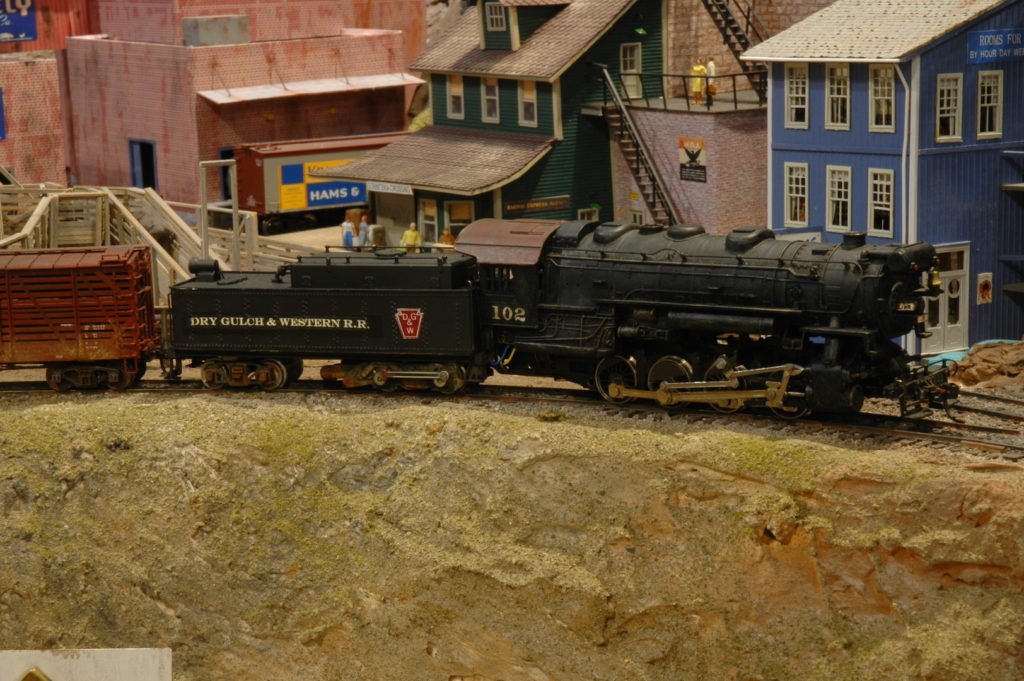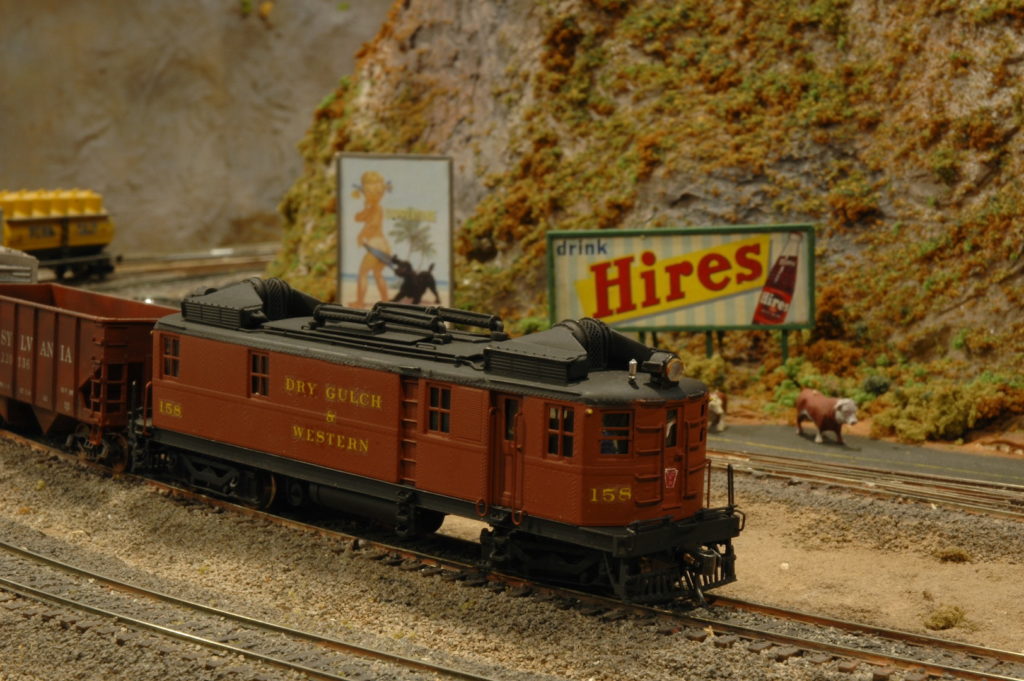Article & Photos By David Yadock
Dry Gulch & Western, Update 2
Not only have I been working on logging locomotives, but I have been adding some rod engines to my fleet. I even added one of those new-fangled diesel things! It seems that all model railroaders have the same problem, too many locomotives. I decided to join the crowd. Again, some of these engines were what I consider “basket case” repair projects. These have always interested me since they can either be used for spare parts or can be resurrected to operating status. I used to be able to obtain these locomotives for a reasonable cost off of Ebay. Over the years that has changed and now parts locomotives command about the same price as their fully functional counterparts.
Photo 7 shows my refurbished PFM 2-6-0 Boston & Maine B-15 locomotive. It was another “basket case” Ebay purchase. Someone tried to re-motor the locomotive but failed in their attempt. The drive assembly was a complete shamble. I installed a newer very small can motor along with a sound decoder and keep alive system. This locomotive has always interested me since it sports a highly detailed front snowplow. I changed out the front cast coupler for a working Kadee coupler on the plow. Doing so was an interesting task.

Photo 8 is my Boston & Albany Custom Brass 4-6-6 tank locomotive. Yet another “basket case”! The cab and boiler needed to be soldered back together (I can’t believe someone used epoxy to glue the two parts of the locomotive back together). It also had some driver issues. There was a short in just one of the drivers. It was located on the center driver and this type of short is a common problem, especially with this locomotive. The paper that is used as an insulator between the hub and wheel rim degrades over time and allows the passage of current. I replaced the paper with new friction tape and the short was eliminated. All the drivers needed quartering. When I purchased this locomotive, it came in pieces and was not put together, so I can understand the quartering issue. The front 4-wheel pony truck was not included, but I found a good substitute on a separate Ebay purchase. This locomotive has been a real challenge. It is still a work in progress since I am still tweaking that front lead truck. The back set of wheels hit parts of the main front frame of the locomotive. I have finally found a solution to the front truck problem but will require a complete disassembly of the locomotive to complete the work. Since I have just gotten the locomotive all put back together, I really do not want to tear it down! It also has a sound decoder and keep alive system installed.

Photos 9 shows my 0-8-0 switcher. This started out as an AHM import of a Rivarossi locomotive. As a plastic model with pizza cutter flanges on its drivers things needed to be changed. I bought this locomotive brand-new many years ago when I first started model railroading. This was from the good old days of code 100 brass track and saw dust scenery! This locomotive had lots of good aspects to it, so I wanted to make it be able to run on my train layout. To get it to that point a lot of work had to be done on this model. A new motor/drive system was constructed and installed. The flanges on the drivers were carefully ground down to follow RP-25 flange size. It had a sound decoder and Keep Alive capacitor system installed along with a sugar cube speaker. A new LED headlight was installed along with a LED flicker firebox light. Finally, a Tenshodo brass “clear vision” tender with booster truck was mated to the locomotive. This heavy locomotive will be used for switching duties in one of my railroad’s yards. I submitted a feature article for publication about the entire process of rebuilding this locomotive and hope to see it in print soon.

Photo 10 is a nod to all you modern diesel fans. This is my Oriental model of an Erie oil electric locomotive. This model was purchased many years ago and it sat in a box. It was in perfect shape. Originally it was to be cut it in half and used for a doodlebug project. I admit I really didn’t want to cut it in half, so that is why it sat in a box! As I was looking though my various locomotives for new projects, I opened this one up. I figured the Dry Gulch & Western needed to step into modern times! So, it now has a diesel. This one only needed paint, window glazing, lighting, addition of a sound decoder, and a Keep Alive system. I was able to use the original motor and driveline. This locomotive went from box to layout in less than a week. I have grown fond of this model since the locomotive was painted and detailed. The roof top vents and piping make it interesting.

There are several other rod locomotive projects that are still patiently waiting their turn for renovation. Currently on the work bench I have three 2-8-0 locomotives that are in the process of being refurbished. On one I have just finished installing the new drive assembly and motor. The boiler and tender have been painted. It is now ready for the installation of the decoder, speaker, and Keep Alive system. The other two are in various stages of driveline design or teardown. Yes, I do all these projects all while working on other projects on the train layout. It really does keep me busy and out of trouble! Next time I’ll begin my updates on the train layout. Quite a few changes have happened, new track has been added or adjusted along with a lot of new scenery.
David

Great articles!